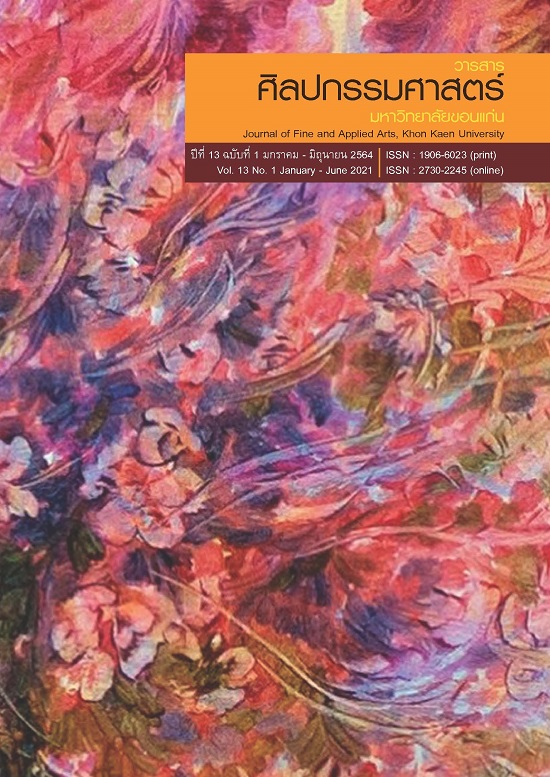Creative Dance of Manni Batad
Main Article Content
Abstract
The research “Manni Batad: A Creative Dance” was aimed at 1) studying history, factors, how to play music, and dancing gestures of Manni tribe living at Ban Wangsaithong, Wangsaithong village, Wangsaithong district in Satun province, 2) analyzing factors, principles and methods in creating tribe dancing gestures, 3) creating Manni Batad tribe performance in forms of Thai dramatic arts by collecting data from textbooks, documents, interviews, and observations of informants as well as people concerned to collect data for the performance. Moreover, there were group discussions to check accuracy and quality of the performance in order to obtain most benefits from them.
The study results revealed that from the study of the performances and dramatic arts of Manni tribe, Satun province, the researcher got the ideas for creating Manni Batad performance. They were music performances and dancing gestures of the tribe people when they safety returned from hunting, they had a fun party and during this there was courting among the young men and women. This type of group performance consisted of 12 male and female performers. The performance created by the researcher imitated that of the tribe people. In the performance there was a kind of musical instrument called “Batad” which was made of bamboo struck to give rhythms. The dance would go along with the music and its gestures could be divided into 5 steps : 1) male performers entered the village performance ground, 2) male performers played the musical instruments, 3) female performers entered the performance ground, 4) courting dance, and 5) performers returned to their cottage. In the performance, the researcher used the original music and created new dancing gestures by imitating the nature and also created new gestures to especially convey the meanings. Apart from the dancing gestures, other features were also created: 1) music: musical instruments which were those for rhythms, those for melodies, and also instruments to imitate sounds of birds, wild cocks, and 2 songs – Manni Batad, and Orang Usli, 2) costumes: Manni tribe costumes were created imitating the original costumes which were long deserted. These were male costume called “Lo Tia” in which a piece of long cloth was worn between the legs and the ends were placed around the waist –the end at the front was called “Kai Pok”, the other end at the back was called “Ko Lo”, a piece of waist tying cloth made from wool and hanging with pieces of bamboo, ornaments: armbands made from bird feather, arm laces, necklace, curl-hair wig, and white flowers hanging over the ears. Female costumes were also created: a piece of knee-length cloth called “Ja Wat”, a strapless blouse was created to replace being naked at the top, a waist tying piece of cloth made from wool and hanging with wild fruits, ornaments: arm bands made from bird feather, arm laces, necklace, ear rings, curl-hair wig, and red flowers hanging over the ears, 3) performance props – a hollow bamboo signal-maker and sticks, fork-end Batad, and straight-end Batad.
Article Details
Content and information in articles published in the Journal of Fine and Applied Arts of Khon Kaen University is regarded as the opinion and sole responsibility of the author(s) directly; therefore, editors are not obliged to agree to or share any responsibility with regard to the content and information that appears within these articles.
All articles, information, content, image, etc. that have been published in the Journal of Fine and Applied Arts of Khon Kaen University is the copyright of the Journal of Fine and Appllied Arts of Khon Kaen University. Any person or organization who wishes to distribute all or parts of the articles for further dissemination or other usage must first receive permission from the Journal of Fine and Applied Arts of Khon Kaen University before proceeding to do so.
References
กรมศิลปากร. (2553). สูจิบัตรละครเรื่องเงาะป่า พระราชนิพนธ์ในพระบาทสมเด็จพระจุลจอมเกล้าเจ้าอยู่. กรุงเทพฯ : สำนักการสังคีต กรมศิลปากร.
พีรพงศ์ เสนไสย. (2546). นาฏยประดิษฐ์. กาฬสินธุ์ : ประสานการพิมพ์.
พีรพงศ์ เสนไสย. (2546). ศิลปะการแสดงตะวันออก. มหาสารคาม : สาขาวิชาศิลปะการแสดง คณะศิลปกรรม มหาวิทยาลัยมหาสารคาม.
ไพบูลย์ ดวงจันทร์. (2541). ดนตรีและนาฏศิลป์ของชนกลุ่มน้อยชาวซาไก. ใน คึกฤทธิ์ ปราโมช (บรรณาธิการ). ลักษณะไทย เล่ม 3 ศิลปะการแสดง. (หน้า 289). กรุงเทพฯ : ไทยวัฒนาพานิช.
เมธินี จิระวัฒนา. (2539). บทละครเงาะป่ากับการดัดแปลงสู่แนวละครร่วมสมัย. วารสารศิลปากร, 39(5), 95.
ยุพร แสงทักษิณ. (2529). บทละครเรื่องเงาะป่า พระราชนิพนธ์ในพระบาทสมเด็จพระจุลจอมเกล้าเจ้าอยู่หัว. กรุงเทพฯ : ไทยร่มเกล้า.
สุรพล วิรุฬห์รักษ์. (2547). หลักการแสดงนาฏยศิลป์ปริทรรศน์. กรุงเทพฯ : สำนักพิมพ์แห่งจุฬาลงกรณ์มหาวิทยาลัย.


